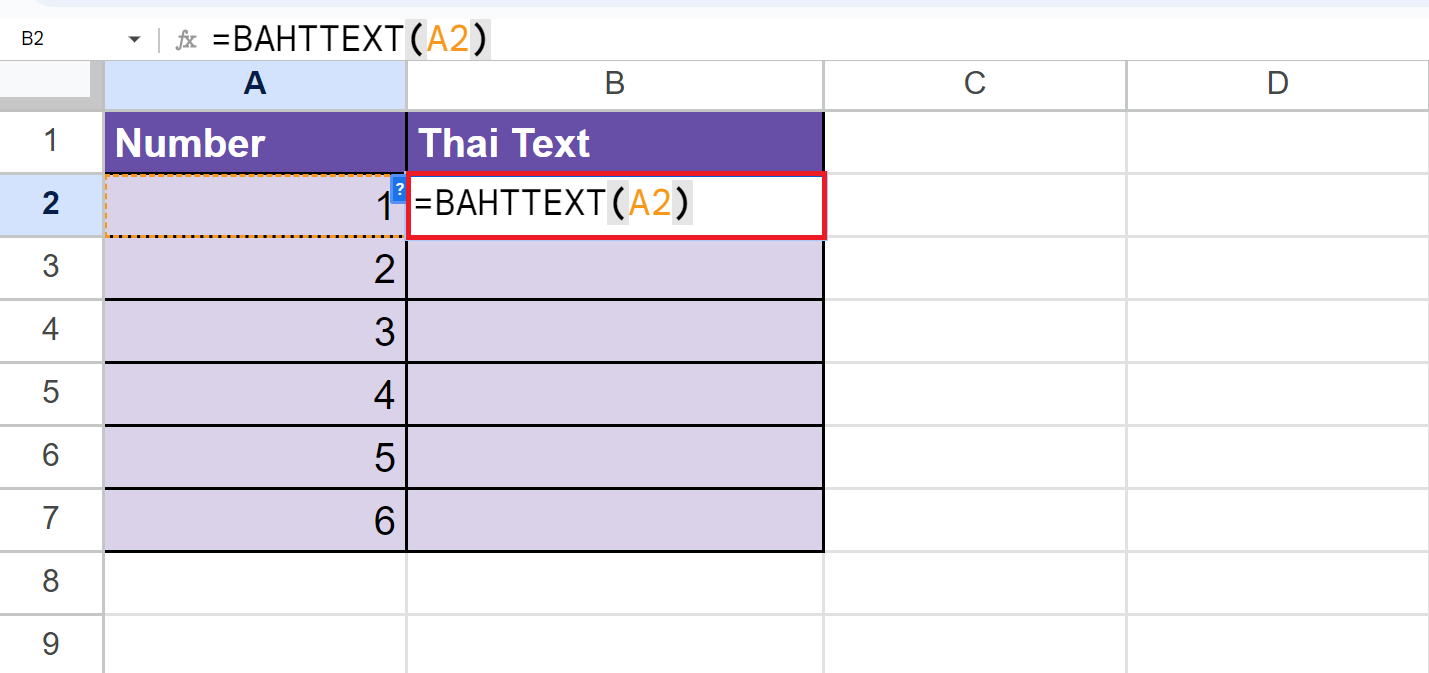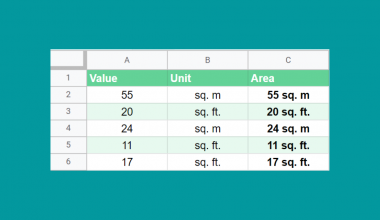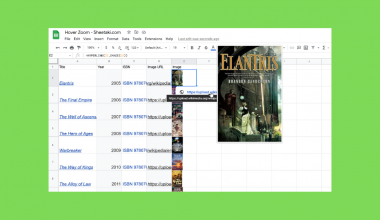This guide will explain how to use the BAHTTEXT function in Google Sheets.
When we need to convert a number to Thai text with the suffix Baht for integer values and Satang for decimal values, we can do this using the BAHTTEXT function in Google Sheets.
Table of Contents
The rules for using the BAHTTEXT function in Google Sheets are the following:
- The
BAHTTEXTfunction converts integer and decimal values. - If we want to convert the negative values, we can wrap the number argument with the
ABS function. - The
BAHTTEXTfunction will evaluate a blank cell to 0 and convert it accordingly. - If we input a text as an argument, the
BAHTTEXTfunction will return a #VALUE! error. - The
BAHTTEXTcan convert numbers that are formatted to text.
Google Sheets is an excellent tool for collaborating with people from different places. However, the language barrier can be a common issue in such situations.
Fortunately, we can utilize several text functions in Google Sheets to solve the issue of the language barrier. This will make it easier for us to collaborate using different languages.
The BAHTTEXT function is used to convert a number to Thai text with the suffix Baht for integer values and Satang for decimal values, making it easier to use Thai numbers when necessary.
In this guide, we will provide a step-by-step tutorial on how to use the BAHTTEXT function in Google Sheets. Additionally, we will explore the syntax and a real example of using the function.
Great! Let’s dive right in.
The Anatomy of the BAHTTEXT Function
The syntax or the way we write the BAHTTEXT function is as follows:
=BAHTTEXT(number)
- = the equal sign is how we start any function in Google Sheets.
- BAHTTEXT() refers to our
BAHTTEXTfunction. This function allows us to convert a number to Thai text with the suffix Baht for integer values and Satang for decimal values. - number is the only required argument. This refers to the number we want to convert into Thai text. This can be a number, cell reference, array, or array reference.
The Anatomy of the GOOGLETRANSLATE Function
The syntax or the way we write the GOOGLETRANSLATE function is as follows:
=GOOGLETRANSLATE(text,[source_language],[target_langauge])
- = the equal sign is how we begin any function in Google Sheets.
- GOOGLETRANSLATE() refers to our
GOOGLETRANSLATEfunction. This function allows us to translate text from one language to another using Google Translate. - text is the only required argument. This refers to the text we want to translate. Furthermore, this can be a text string enclosed in quotation marks or a cell reference containing the text string.
- source_languge is an optional argument. This refers to the language code of the source text. If omitted, Google Translate will try to detect the source language automatically by default.
- target_language is another optional argument. This is the language code of the target language we want to translate the text into. When omitted, the default target language is English or the system language the current spreadsheet is using.
A Real Example of Using BAHTTEXT Function in Google Sheets
Let’s say we have a list of numbers we need to convert into Thai text for collaborative work. Our initial data set would look like this:

In the spreadsheet above, we can see a list of numbers. We want to convert the numbers to Thai text. In this case, we can easily do this using the BAHTTEXT function.
We can use the formula below:
=BAHTTEXT(A2)

The formula only has one required argument. We simply selected cell A2 which contains the number we want to convert into Thai text.
Our final data set would look like this:

Additionally, we can translate the converted Thai text into English using the GOOGLETRANSLATE function. The function is used to translate text values to another chosen language.
To do this, we can apply the formula below:
=GOOGLETRANSLATE(B2,"th","en")

The first part of the formula refers to the text argument. In this case, we selected cell B2 with the text we want to translate. Since we are selecting a Thai text, we will input the language code “th” as our source_language argument.
Lastly, we want to translate the text strings into English. Hence, our target_langauge argument in the formula is “en”.
The final data set using the GOOGLETRANSLATE function would look like this:

You can make your own copy of the spreadsheet above using the link below.
Amazing! Now we can dive into the steps of using the BAHTTEXT function in Google Sheets.
How to Use BAHTTEXT Function in Google Sheets
1. First, we will create another column in the data set to display the converted numbers in Thai text.
2. To begin, we will type an equal sign and the function name, giving us the formula “=BAHTTEXT(”.
3. Then, we will simply select the cell containing the number we want to convert. Our formula would be ”=BAHTTEXT(A2)”.
4. We will press the Enter key to return the result.
5. Next, we will drag down the Fill Handle tool to copy and apply the formula to other cells.
6. Additionally, let’s use the GOOGLETRANSLATE function with the BAHTTEXT function to translate the Thai text into English. To start, we will type in an equal sign and the function name. Our formula would be “=GOOGLETRANSLATE(”.
7. Then, we will select the cell containing the text we want to convert. The formula would become “=GOOGLETRANSLATE(B2”.
8. We will utilize the optional argument. First, we will input the source language of the text we want to translate. In this case, the text string is in Thai. Our formula would be “=GOOGLETRANSLATE(B2,”th””.
9. We want to translate the text strings from Thai to English. Next, we will type in the language code of English, which is en. Our final formula would be “=GOOGLETRANSLATE(B2,”th”,”en”)”.
10. We will press the Enter key to return the result.
11. Lastly, we will drag down the Fill Handle tool to copy the formula and apply it to the other cells.
And tada! We have successfully used the BAHTTEXT function in Google Sheets.
You can apply this guide whenever you need to convert a number to Thai text with the suffix Baht for integer values and Satang for decimal values. You can now use the BAHTTEXT function and the various other Google Sheets formulas available to create great worksheets that work for you.
FAQs
1. How do I input an array in my BAHTTEXT formula?
The BAHTTEXT function supports array or array references as a number argument. You must use the ARRAYFORMULA function when inputting an array.
For example, you can input =ARRAYFORMULA(BAHTTEXT({1;2;3;4;5})). The previous formula converts the numbers 1 to 5 into Thai language text.
Alternatively, you can also use a cell reference =ARRAYFORMULA(BAHTTEXT(A2:A6)).
2. Why did my formula return a #VALUE! error?
The BAHTTEXT function will return a #VALUE! error if the given number argument is not recognized as a numeric value in Google Sheets.
That’s pretty much it! Make sure to subscribe to our newsletter to be the first to know about the latest guides and tutorials from us.







